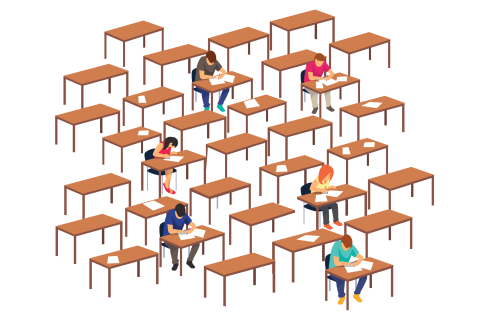Facing the Future with Fewer Learners

Enrollment decline lurks behind many conversations in education, fueling concern across the spectrum from early childhood through higher education. After all, many of our systems, institutions, and laws are predicated on the continued growth in students.
Enrollment declines in both K–12 and higher education are influenced by several factors. In K–12, declining birth rates and increased educational alternatives, such as homeschooling and private schooling, have contributed to reduced public school enrollment. In higher education, factors like demographic shifts, affordability concerns, and skepticism about the value of a college degree have led to decreased college enrollment.
With these causes in mind, it’s worth reflecting on what we know and considering the consequences of a stagnant-to-low enrollment future.
Enrollment Data in Kansas
K-12 public school enrollment in Kansas has remained largely stagnant over the past decade, with only a slight statewide decline of -.3%: from 463,266 full-time equivalent (FTE) students in 2015 to 461,902 in 2024.
While statewide totals have held steady, the underlying story is one of divergence. Rural and small-town districts, especially in western and southeastern Kansas, are disproportionately experiencing enrollment losses. For example, Healy (USD 468) lost 70.5% of its student population; Fowler (USD 225) and Rolla (USD 217) lost 54.2% and 51.5%, respectively, over the last ten years.
On the other hand, suburban and exurban districts, especially those located in or near the KC and Wichita metro areas, have seen large enrollment gains. Districts like Spring Hill (USD 230), Piper-Kansas City (USD 203), and Blue Valley-Riley (USD 384) reported growth of more than 40%.
In addition, Kansas higher education enrollment has also declined modestly in the past five years, but recent data from Fall 2024 show signs of stabilization. While enrollment across the system is up 4% from last year, it is down -2.6% compared to 2019 enrollment levels. What’s more, the rebound in enrollment is uneven: some institutions have continued to lose students while others are experiencing growth that outpaces pre-pandemic levels.
Enrollment Data in Missouri
Missouri’s K-12 public school FTE enrollment has experienced a gradual decline over the past seven years, dropping from 882,261 students in 2017 to 858,053 in 2024 — a -2.7% decrease. The sharpest dip occurred during the 2020–21 school year, likely due to pandemic-related disruptions, and while there was a brief rebound in 2022, enrollment has continued to inch downward.
Unlike Kansas, Missouri does not present district-level enrollment data in a format that allows for easy statewide analysis, making it difficult to identify broad trends across district types. Public reporting suggests that suburban districts in areas like St. Charles County, Lee’s Summit, and Wentzville have largely experienced growth or stability.
Missouri’s higher education enrollment has steadily declined over the past five years, according to the most recent data. FTE enrollment as of Fall 2024 remains below pre-pandemic levels across all sectors (-6.4%), although the pace of decline has slowed or flattened in some areas.
- Public Four-Years: Enrollment is down -6.1% over five years but remained flat between 2023-2024. Most institutions are experiencing declines with only the University of Missouri-Columbia and Northwest Missouri State University gaining students (9.8% and 3.3% over five years, respectively).
- Public Two-Years: While enrollment over five years is down -4.5%, it has grown 3.9% between 2023-2024 and 5% over the last three years, showing positive signs of rebounding.
- Independent Institutions: For Independent four-year institutions, overall enrollment is down -7%. However, this category has wide variance: a few institutions are growing very fast — look at Avila University growing 58% — whereas others are losing more than half of their student population over five years. (No data is available for independent two-year institutions).
Looking Forward
The National Center on Education Statistics releases long-term projections for K-12 enrollment, with the most recent data indicating widespread enrollment decline picking up through 2031.
Kansas and Missouri are expected to lose an additional -7% and -3% of K-12 students, respectively. They are projected to join the other 40 states with lower enrollment totals in the future; only 10 states are expected to grow their student population in six years.
NCES also provides projections for total higher education enrollments, showing a leveling off if not marginal decline through 2030. Much will depend on college-going rates going forward.
As student counts decline, the fiscal pressure intensifies. Both K-12 and higher education systems are fundamentally tied to enrollment. In K-12, state funding formulas are based on the number of students served, while higher education institutions depend on tuition revenue and state appropriations that are often enrollment-driven.
In response, many districts and institutions are weighing difficult decisions—pausing new hires, reducing staff, rethinking academic offerings, and in some cases, consolidating with neighboring schools or campuses.
Still, it’s important to recognize that declining enrollment is not universally negative. Smaller student populations can lead to lower student-to-teacher ratios and more personalized learning environments. But for many small and rural districts, the loss of students—and the resources that follow—raises existential questions about long-term viability and community identity.
Aligned’s Take: Enrollment declines may appear gradual, but their implications are far-reaching. Addressing them will demand hard choices at both the state and local levels. Our response — how we retool institutions and redesign policies — will ultimately define how education adapts to a future with fewer students.